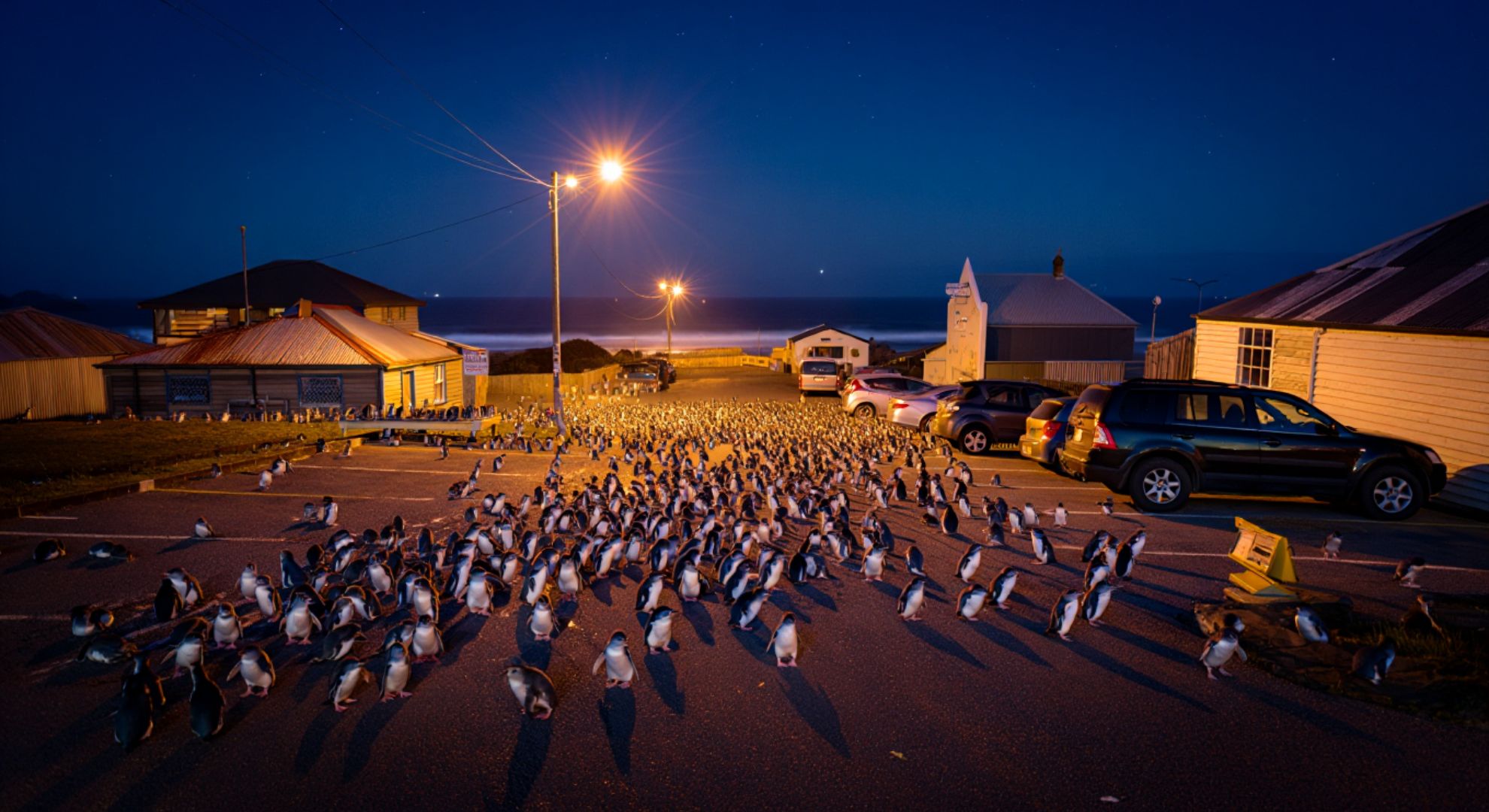Oamaru might be a small coastal town in New Zealand, but every evening something magical and rather unexpected happens once the sun sets. Residents and visitors alike linger in their cars, cameras at the ready, to catch a glimpse of a most unusual urban takeover: dozens of tiny blue penguins waddling across the asphalt, seemingly unfazed by the modern world that surrounds them. These little visitors are no ordinary city dwellers — they are the world’s smallest species of penguin, and they’ve chosen a car park as their nighttime stage.
A Surprising Urban Colony
In a world increasingly dominated by concrete, one might assume wildlife would keep a safe distance. Not so for these penguins. Each night, they leave the turbulent embrace of the Pacific Ocean, climb up steep rocks with surprising determination, and emerge onto the cold, hard car park in the heart of Oamaru. Under flickering lamplight, they shuffle past parked vehicles on their way to burrows built alongside the historic harbour.
“We thought only cats and dogs roamed the streets at night,” laughs Sarah Williams, a local shop owner. “It’s quite surreal to see these little guys waddling about instead. They’re the real citizens here after dark.”
An Oceanic Lifestyle, an Urban Twist
Little blue penguins – or kororā in Māori – usually make their nests on secluded beaches or in rocky crevices. But Oamaru’s urban fringe offers advantages: shelter beneath old timber buildings and protection from their arch-nemesis, the stoat. In return, the penguins bring an unexpected liveliness to the town’s otherwise sleepy waterfront once rush hour fades away.
At just 30 centimeters tall and weighing barely over 1 kilogram, they are perfectly sized for squeezing into nooks that most predators can’t reach. People who park in the lot after sunset are sometimes shooed away by penguin wardens, who dutifully protect these feisty birds from folks unaware of their fragile nightlife.
Why Oamaru?
The story of Oamaru’s penguins is tightly woven into the town’s identity. Over the years, the community has grown fiercely protective of their tiny blue guests. Fencing and low lighting help keep the birds safe, while interpretive signs in several languages ask visitors to keep noise to a minimum.
“People travel from all over just to watch this spectacle,” says Mark Graham, a local ranger. “It’s become a point of pride, but also a great responsibility.”
Comparing Popular Penguin Colonies
Let’s see how Oamaru’s unique car park colony stacks up against other famous penguin habitats:
| Colony | Species | Habitat Type | Human Interaction | Height (cm) | Avg. Population |
|---|---|---|---|---|---|
| Oamaru, NZ | Little Blue | Urban/Harbour | Highly Protected, Close | 30 | 150+ pairs |
| Phillip Island, Aus | Little Blue | Coastal/Island | Managed boardwalks | 33 | 32,000+ pairs |
| Boulders Beach, SA | African Penguin | Beach/Urban | Touristed, Boardwalks | 60-70 | 2,000-3,000 |
| Punta Tombo, Arg. | Magellanic | Coastal/Natural | Distant boardwalks | 45 | 200,000+ pairs |
Oamaru is unique not in its species, but in just how urban its penguin colony has become — parking lots are rarely anyone’s image of a penguin’s natural home!
Respecting Penguin Privacy
Local authorities, wildlife organizations, and community volunteers all play a role in ensuring the safety and well-being of the penguins. While the human fascination is understandable, it’s important to remember that these birds need both space and silence.
If you plan to visit, keep these key tips in mind:
-
- Keep your headlights off near nesting sites.
-
- Move quietly and avoid loud talking or sudden gestures.
-
- Never use a flash when taking photos.
-
- Stay behind marked barriers or listen to instructions from wardens.
-
- Leave your pets at home.
Failure to respect these rules can be detrimental to the penguins’ wellbeing, and local volunteers aren’t shy about reminding tourists of their responsibilities.
Unlikely Stars of the Night
For the people living in Oamaru, the penguins symbolize a delightful intersection between nature and the built environment. Children are often the first to spot the blue flashes between tires, and even lifelong residents admit they still feel a tingle of excitement each night. As Tom Jensen, a local taxi driver, puts it, “They own this place after dark. We just borrow it for the rest of the day.”
As more towns face the pressure of urban expansion, the example set by Oamaru serves as a reminder: with care, respect, and a little whimsy, wildlife and people can share the strangest of spaces — even a town car park, echoing with the soft, happy sounds of feathered feet.
